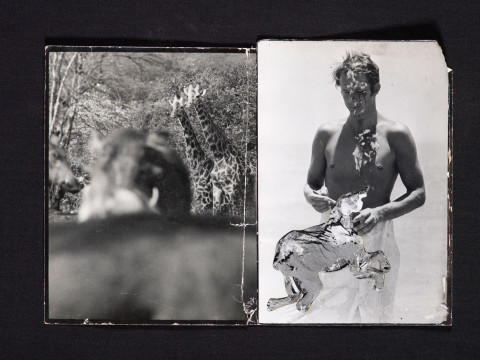
From Soho to sunshine: the Francis Bacon you never knew
By Sam Phillips
Published on 12 July 2016
We know him as the doyen of dingy 1960s Soho. But a major exhibition in Monaco reveals the British painter in a more Mediterranean light, showing how he drew inspiration from the French Riviera. The editor of RA Magazine takes a visit.
When I used to think of Francis Bacon, I always imagined gloomy London interiors, the painter in his murky, messy Reece Mews studio, or propping up the bar in the smoke-filled Colony Room in Soho.
But a significant show at Monaco’s Grimaldi Forum has drawn back the curtains on this dinge, shedding sunlight on Bacon and arguing for an alternative idea of the man: Francis the Francophile, who sojourned at every opportunity to Paris, Monaco and the French Riviera, absorbing ideas aplenty from French painting while he was at it.
The argument pivots on a period in the late 1940s when Bacon moved to Monaco, during which he began a significant series of paintings of heads, including Head VI (1949). This is the earliest surviving of his "Pope" paintings – works that take Velazquez’s portrait of Pope Innocent X (c.1650) in a decidedly existential direction. The purple-robed Pope sits – as if restrained – in a rudimentary cube, his mouth open in agony, his eyes, nose and upper face eradicated by downward daubs of black. On display in one of the exhibition’s opening spaces, it has a high-octane hellishness that is rarely matched in the works that follow.


Head VI, 1949

Watercolour, 1929
MB Art Collection

Turning Figure , 1962
Bacon loved the region’s climate – it helped his chronic asthma – but also Monaco’s famed casino. "I became obsessed by the casino and I spent whole days there," he told David Sylvester in 1966, "and there you could go in at ten o’clock in the morning and needn’t come out until about four o’clock the following morning...." It is tempting to extend gambling as a metaphor for Bacon’s art, to speculate that he took more risks than his contemporaries because of his love for a flutter. During his time in Monaco, Bacon first began painting on the unprimed side of the canvas; the story goes that he had lost all his cash at roulette, so instead of buying a new canvas he had to recycle the back of an old one, and realised he preferred the unprimed surface.

The artist’s relationship to Monaco is an obsession of Majid Boustany, a Lebanese-born property developer, art collector and philanthropist. With the blessing of the Bacon estate, Boustany has established the Francis Bacon MB Art Foundation in a Monégasque villa. The foundation supports research, events and exhibitions about the artist, including the Grimaldi Forum show, to which it has loaned the earliest surviving Bacon, Watercolour (1929).
This Cubist interior, displayed in a section entitled Inspirations, sees the 20-year-old Bacon drawing on the work De Chirico, Léger and Picasso. The latter’s work was "profoundly unillustrative but profoundly real about figures", in Bacon’s words; in other rooms, one sees how brilliantly Bacon learned from Picasso to create his own signature style of biomorphism, in which men’s muscles are mangled or merged.
A breathtaking example is triptych Studies of the Human Body (1970), painted for Bacon’s 1971 Grand Palais retrospective. The three oils are suspended away from the wall, so that the work appears to float in space in the same way as its subjects. Such bold exhibition design is one of the show’s great strengths. The cavernous Grimaldi Forum space, often used as a conference venue, has been a help and not a hindrance in this respect, allowing the curators to design walls and lighting around the requirements of the 66 Bacons.

But as I emerged into the summer sun, a question troubled me. If Head V is one of the 20th century’s most affecting images of anxiety, how could it be made in the benign world of the French Riviera? Excluding a rare Bacon seascape, little in the show is emblematic of the coast or the atmosphere of Southern France. The show, in this way, is an argument against the direct connection of a work of art and the place it is made – perhaps it was just distance and time that Bacon needed, and Monaco allowed him both.

Francis Bacon: Monaco and French Culture, Grimaldi Forum, Monaco, 2 July–2 September; the exhibition travels to the Guggenheim Museum, Bilbao, 30 September–8 January. An accompanying book, Francis Bacon: France and Monaco, edited by Martin Harrison, is co-published by Albin Michel and The Francis Bacon MB Art Foundation, in partnership with Heni Publishing, £35.00. Francis Bacon MB Foundation, Monaco +377 93 30 30 33, open by appointment.
Sam Phillips is Editor at RA Magazine

Enjoyed this article?
"As well as free entry to all of our exhibitions, Friends of the RA enjoy one of Britain’s most respected art magazines, delivered directly to your door. Why not join the club? "
Related articles

Francis Bacon: "I'm always labelled with horror"
5 April 2022

On safari with Francis Bacon
1 April 2022

Quiz: which artist are you?
1 March 2022

13 things to know about Francis Bacon
14 February 2022

The truth in Francis Bacon's work
19 November 2021
